|
|
 |
|
Calanoida ( Order ) |
|
|
|
Diaptomoidea ( Superfamily ) |
|
|
|
Candaciidae ( Family ) |
|
|
|
Candacia ( Genus ) |
|
|
| |
Candacia varicans (Giesbrecht, 1892) (F,M) | |
| | | | | | | Syn.: | Candace varicans Giesbrecht, 1892 (p.424, 439, 771, figs.F,M); T. Scott, 1894 b (p.62, figs.F,M);
Candacia sp. Pesta, 1941 (p.168, figs.M);
Cadancia boricans: Cervantes-Duarte & Hernandez-Trujillo, 1989 (tab.3: lapsus calami) | | | | Ref.: | | | Giesbrecht & Schmeil, 1898 (p.129, Rem. F,M); Wolfenden, 1911 (p.357); Rose, 1929 (p.44); Farran, 1929 (p.210, 273); Sewell, 1932 (p.338); Rose, 1933 a (p.252, figs.F,M); Lysholm & al., 1945 (p.41); Sewell, 1947 (p.248); Farran, 1948 b (n°13, p.3, figs.F,M); Marques, 1953 (p.120, fig.F); Grice, 1962 (p.234, figs.F,M); 1963 (p.179, fig.F); Crisafi, 1963 (p.129, figs.F,M, juv.); Vervoort, 1965 (p.174, Rem.); Owre & Foyo, 1967 (p.94, figs.F,M); Shih & al., 1971 (p.37); Razouls, 1972 (p.95, Annexe: p.88, figs.F,M); Lawson, 1977 (p.71, tab.2,3,4, fig.5); Björnberg & al., 1981 (p.655, figs.F,M); Baessa De Aguiar, 1991 (1993) (p.102, figs.F); Boxshall & Huys, 1998 (p.780); Bradford-Grieve & al., 1999 (p.885, 956, figs.F,M); Bradford-Grieve, 1999 b (p.174, figs.F,M, Rem., figs.183,193); G. Harding, 2004 (p.25, figs.F,M); Vives & Shmeleva, 2007 (p.456, figs.F,M, Rem.) | 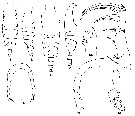 issued from : G.D. Grice in Fish. Bull. Fish and Wildl. Ser., 1962, 61. [p.233, Pl.31, Figs.8-16]. Female (ffrom equatorial Pacific): 8-9, dorsal and lateral, respectively); 10, P5. Long and symmetrical genital segment wihich is produced on the ventral side. P5 slightly asymmetrical and terminate in two rather long, but unequal, points. Male: 11-12, habitus (dorsal and lateral, respectively); 13, Md (citing edge); 14, Mx2; 15, left P5; 16, right P5. Nota: Thorax and genital segment symmetrical. The basal tooth of Md ends in 3 approximately equal cusps. Right P5 chelate.
|
 issued from : C. Razouls in Th. Doc. Etat Fac. Sc. Paris VI, 1972, Annexe. [Fig.55, C]. Male (from Banyuls): C, right A1.
|
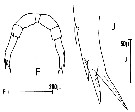 issued from : C. Razouls in Th. Doc. Etat Fac. Sc. Paris VI, 1972, Annexe. [Fig.53, F, J]. Female (from Banyuls): F, P5; J, distal portion of P5.
|
 Issued from : J.M. Bradford-Grieve, E.L. Markhaseva, C.E.F. Rocha & B. Abiahy in South Atlantic Zooplankton, edit. D. Boltovskoy. 1999, Vol. 2, Copepoda; [p.1066, Fig. 7.374: Candacia varicans ]. r = right leg of male P5. Female characteristics (from key, p.956) : - Terminal segment of P5 with 2 outer spines and 2 distal spines. - No spine-like process present on ventral side og genital segment. - Noinner edge setae present on terminal segment of P5. - Urosomal segment 2 without lateral or ventral protrusion a,d without spine-like process arising from ventral surface. - Posterior corners of prosome pointed. Male characteristics (from key, p.956) : - Proximal spine on Mx2 inner lobe 5 not notably thicker than distal spine. - In dorsal view, genital segment without process or protrusion. - Left posterior corner of the prosome pointed.
|
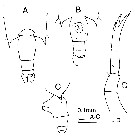 issued from : Bradford-Grieve J.M. in The Marine Fauna of New Zealand: Pelagic Calanoid Copepoda. National Institute of Water and Atmospheric Research (NIWA). NIWA Biodiversity Memoir, 111, 1999. [p.176, Fig.126, A-D]. Female: A, urosome (dorsal); B, idem (ventral); C, idem (left lateral side); D, P5.
|
 issued from : Bradford-Grieve J.M. in The Marine Fauna of New Zealand: Pelagic Calanoid Copepoda. National Institute of Water and Atmospheric Research (NIWA). NIWA Biodiversity Memoir, 111, 1999. [p.176, Fig.126, E-G]. Male: E, urosome (dorsal); F, part of geniculate A1; G, P5. L = left leg; R = right leg. Nota: Male left P5 with 2 terminal segments hairy in the Southwest Pacific specimens.
|
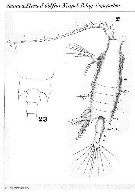 Issued from : W. Giesbrecht in Fauna Flora Golf. Neapel, 1892, 19. [Taf. 39, figs. 2, 23]. Female: 2, habitus (dorsal). Male: 23, Thoracic segment 5 and abdominal segments 1 and 2.
| | | | | Compl. Ref.: | | | Cleve, 1904 a (p.187); Wilson, 1942 a (p.175); Sewell, 1948 (p.346, 419, 427, 443, 457, 460, 470, 473, 477, 490); C.B. Wilson, 1950 (p.184); V.N.Gaudy, 1962 (p.93, 99, Rem.: p.112) ; Greze, 1963 a (tabl.2); De Decker & Mombeck, 1964 (p.11); Mazza, 1966 (p.72); Pavlova, 1966 (p.44); Fleminger, 1967 a (tabl.1); Séguin, 1968 (p.488); De Decker, 1968 (p.45); Morris, 1970 (p.2301); Timonin, 1971 (p.281, trophic group); Roe, 1972 (p.277, tabl.1, tabl.2); Bainbridge, 1972 (p.61, Appendix Table III: occurrence); Apostolopoulou, 1972 (p.328, 366); Deevey & Brooks, 1977 (p.156, tab.2, Station "S"); Carter, 1977 (1978) (p.36); Dessier, 1979 (p.206); Pipe & Coombs, 1980 (p.223, Table II, vertical occurrence); Vaissière & Séguin, 1980 (p.23, tab.2); Kovalev & Shmeleva, 1982 (p.85); Vives, 1982 (p.294); Tremblay & Anderson, 1984 (p.4); De Decker, 1984 (p.317); Scotto di Carlo & al., 1984 (1044); Guangshan & Honglin, 1984 (p.118, tab.); Cummings, 1984 (p.163, Table 2); Regner, 1985 (p.11, Rem.: p.37); Brenning, 1985 a (p.28, Table 2); Madhupratap & Haridas, 1986 (p.105, tab.1); Brenning, 1987 (p.30, spatial distribution, T-S diagram, Rem.); Jimenez-Perez & Lara-Lara, 1988; Lozano Soldevilla & al., 1988 (p.60); Heinrich, 1990 (p.19); Suarez & al., 1990 (tab.2); Suarez & Gasca, 1991 (tab.2); Suarez, 1992 (App.1); Seguin & al., 1993 (p.23); Shih & Young, 1995 (p.69); Suarez-Morales & Gasca, 1997 (p.1525); Hure & Krsinic, 1998 (p.102); Alvarez-Cadena & al., 1998 (tab.1,2,3,4); Suarez-Morales, 1998 (p.345, Table 1); Suarez-Morales & Gasca, 1998 a (p109); Siokou-Frangou, 1999 (p.478); Hernandez-Trujillo, 1999 (p.284, tab.1); Neumann-Leitao & al., 1999 (p.153, tab.2); Lopez-Salgado & al., 2000 (tab.1); Lapernat, 2000 (tabl.3, 4); Holmes, 2001 (p.30); Vukanic, 2003 (p.139, tab.1); Osore & al., 2004 (p.195); Isari & al., 2006 (p.241, tab.II); Khelifi-Touhami & al., 2007 (p.327, Table 1); Neumann-Leitao & al., 2008 (p.799: Tab.II, fig.6); Morales-Ramirez & Suarez-Morales, 2008 (p.518); Gaard & al., 2008 (p.59, Table 1, N Mid-Atlantic Ridge); Licandro & Icardi, 2009 (p.17, Table 4); Schnack-Schiel & al., 2010 (p.2064, Table 2: E Atlantic subtropical/tropical); Mazzocchi & Di Capua, 2010 (p.424); Tutasi & al., 2011 (p.791, Table 2, abundance distribution vs La Niña event); Pagano & al., 2012 (p.538, Table 1); in CalCOFI regional list (MDO, Nov. 2013; M. Ohman, comm. pers.) ; Lidvanov & al., 2013 (p.290, Table 2, % composition); Benedetti & al., 2016 (p.159, Table I, fig.1, functional characters); El Arraj & al., 2017 (p.272, table 2, spatial distribution); Benedetti & al., 2018 (p.1, Fig.2: ecological functional group); Belmonte, 2018 (p.273, Table I: Italian zones); Chaouadi & Hafferssas, 2018 (p.913, Table II: occurrence). | | | | NZ: | 18 | | |
|
Distribution map of Candacia varicans by geographical zones
|
| | | | | | | | | | | | 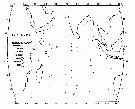 issued from : T.J. Lawson in Marine Biology, 1977, 43. [Fig.5, p.82]. issued from : T.J. Lawson in Marine Biology, 1977, 43. [Fig.5, p.82].
Distribution map for the Indian Ocean. |
 issued from : U. Brenning in Wiss. Z. Wilhelm-Pieck-Univ. Rostock - 36. Jahrgang 1987. Mat.-nat. wiss. Reihe, 2. [p.27, Fig.1]. issued from : U. Brenning in Wiss. Z. Wilhelm-Pieck-Univ. Rostock - 36. Jahrgang 1987. Mat.-nat. wiss. Reihe, 2. [p.27, Fig.1].
Spatial distribution for Candacia curta, C. armata, C. bipinnata, C. paenelongimana, C. varicans (= varians), C. pachydactyla, C. longimana, C. ethiopica, Paracandacia simplex ( = C. simplex) from 8° S - 26° N; 16°- 20° W, for different expeditions (V1: Dec. 1972- Jan. 1973; V2: Feb/Mar. 1973; VI: May 1974; IV: Jun./Jul. 1972). |
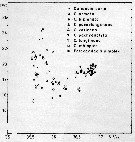 issued from : U. Brenning in Wiss. Z. Wilhelm-Pieck-Univ. Rostock - 36. Jahrgang 1987. Mat.-nat. wiss. Reihe, 2. [p.28, Fig.2]. issued from : U. Brenning in Wiss. Z. Wilhelm-Pieck-Univ. Rostock - 36. Jahrgang 1987. Mat.-nat. wiss. Reihe, 2. [p.28, Fig.2].
T-S Diagram for Candacia curta, C. armata, C. bipinnata, C. paenelongimana, C. varicans, C. pachydactyla, C. longimana, C. ethiopica, Paracandacia simplex ( = C. simplex) from 8° S - 26° N; 16°- 20° W. |
| | | | Loc: | | | South Africa (E & W), Namibia, Angola, Congo, off N St. Helena Is., Sao Tomé, G. of Guinea, off Lagos, off NE St. Paul Is., Cape Verde Is., off NW Cape Verde Is., Morocco-Mauritania, Canary Is., off Madeira, Azores, Portugal, SW Atlant., Brazil (off Natal), off. Amazon, Venezuela, E Antilles, Yucatan, G. of Mexico, Florida, off Bermuda (Station "S"), Sargasso Sea, off Nova Scotia, G. of St. Lawrence, off Newfoundland, off S Iceland, W Ireland, Wyville Thomson Ridge, Medit. (Alboran Sea, Habibas Is., Sidi Fredj coast, Gulf of Annaba, NW, Banyuls, Marseille, Ligurian Sea, Tyrrhenian Sea, Strait of Messina, Adriatic Sea, Ionian Sea, Aegean Sea, Lebanon Basin), Red Sea, Arabian Sea, Laccadive Is., Kenya, Indian, Philippines, China Seas (East China Sea, South China Sea), Bering Sea, Pacif. (W equatorial), New Zealand (North Island N), Tasman Sea, Pacif. (equatorial), off N Hawaii, California, W Baja California, G. of California, W Costa-Rica, Pacif. (SE tropical), Galapagos-Ecuador, Tuamotu (Ahe atoll) | | | | N: | 100 (S Atlant.: 15; N Atlant.: 32; Medit.: 25; Red Sea: 1; Indian: 11; Indo-Malaysia: 1; Pacif.: 14) | | | | Lg.: | | | (16) F: 2,5-2,25; M: 2,4-2,25; (46) F: 2,3; M: 2,1; (101) F: 2,55; M: 2,28-2,14; (199) F: 2,43-1,98; M: 2,13; (342) F: 2,457-1,989; M: 2,424-1,913; (909) F: 2,3-2,4; M: 2-2,3; (1110) F: 2,63-2,74; {F: 1,98-2,74; M: 1,91-2,42}
The mean female size is 2.377 mm (n = 12; SD = 0.2309), and the mean male size is 2.194 mm (n = 10; SD = 0.1665). The size ratio (male : female) is 0.936 (n = 6; SD = 0.0449). | | | | Rem.: | epi-mesopelagic. Sargasso Sea: 500-1000 m (Deevey & Brooks, 1977, Station "S"). 410-450 m (Pipe & Coombs, 1980 at 60°N, 07°W)
For C.B. Wilson (1950, p.184) this species is one of the rarer form, and these Albatross specimens constitute the second record from the Pacific area, Sewell having reported it from the Indian Ocean (1932, p.338).
Timonin (1971, p.282) considers the trophic interrelations in the equatorial and tropical Indian Ocean, and divides the plankters into 6 trophic groups from the litterature and the results of studies of mouth-parts structure and intestine content. This species is a piercing and sucking carnivorous.
After Benedetti & al. (2018, p.1, Fig.2) this species belonging to the functional group 2 corresponding to small ambush feeding carnivorous. | | | Last update : 25/10/2022 | |
|
|
 Any use of this site for a publication will be mentioned with the following reference : Any use of this site for a publication will be mentioned with the following reference :
Razouls C., Desreumaux N., Kouwenberg J. and de Bovée F., 2005-2025. - Biodiversity of Marine Planktonic Copepods (morphology, geographical distribution and biological data). Sorbonne University, CNRS. Available at http://copepodes.obs-banyuls.fr/en [Accessed August 17, 2025] © copyright 2005-2025 Sorbonne University, CNRS
|
|
 |
 |













